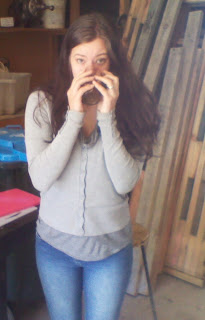When I turned up to the Ale Brewing Chaps new
brewery this morning to learn how to make beer, I hadn’t a clue what to expect.
I’d done some chemistry at University, and I’m a dab hand in the kitchen, so I
wasn’t too worried, but I’m the kind of person who always harbours lingering
doubts, particularly where my own abilities are concerned.
Of course, I’ve known Alan Knight for
years, and I’m quite comfortable in any situation where he is telling me what
to do. We’ve worked on numerous excellent theatrical productions together, all
of which involved me as a cast member of some description and Alan as our visionary
director. I was hoping this would be more of the same.
It was.
Some people, particularly on Waiheke
(you know who you are), run habitually late. They justify their tardiness by
saying they run on what is known as “island time”. Unfortunately I am
geographically misplaced; I have the opposite problem, and tend to run early.
Today was no exception, so Alex and I went over the road to see Jerry at IMech,
so Alex (who is a fledgling mechanic) could admire what I’m told was a very
fine example of a gear box.
Then a text from Alan: It’s show time.
After
arriving, and observing a moment of silence for the late Neil Armstrong, we got
down to the serious business of brewing a beer in honour of the great man’s
life. I think we call it Armstrong Ale, but after the beer we drank to
commemorate a successful brew, I really can’t be sure.
I can’t
believe I never tried brewing beer before. It’s so much fun. Who wouldn’t want
to play with a cross between a giant chemistry set and a kitchen?
This was
what our giant vat of cereals and malt looked like. Alan explained all about
how the malt’s sugars and enzymes would do most of the leg-work to create our
beer. He also explained the importance of having clean fermenting tanks.
So here I
am cleaning them.
And here I
am doing some further cleaning.
Something
you may not know about brewing beer, is that it involves lots of waiting. After
you lay down the mash, which is made of crushed barley malt, cereals and hot
water, there is some waiting (that’s when the starch in the malt gets degraded
to fermentable sugars). Once you have carefully and slowly strained off the
sweet wort and transferred it to the kettle for boiling, there is more waiting.
Thankfully waiting is not an issue for me.
I have as much patience as I have
knitting.
The sweet wort was delicious.
Very sweet and hot, trying it reminded me of being a small child during a cold
winter and being given a taste of Mum’s mulled wine, which she’d inadvertently
boiled all the alcohol off.
It’s the
kind of beverage you just want to wrap your hands around.
After
transferring the sweet wort to the kettle, this was the moment when I knew all
was proceeding to plan.
The plan
was to make a monstrously well hopped beer. When I’d first arrived Alan had
said we would be using all the hops in the building to complete this brew. He
told me to weigh them all. We had four different varieties of hops. There were
varying amounts of each, 1.5kg all told. We decided that would be too hoppy,
even for us, so we went down to 600g of hops.
Here I am
adding some hops. See that hat? Yes. I knitted it.
After the
final hopping it was time to put the hopped wort and yeast in the fermenting
tanks and wrap them up nice and warm.
I’ve just
begun the process of learning how to make beer, but I took this as a sign of
good things to come.
* Title credit: Linds Redding







